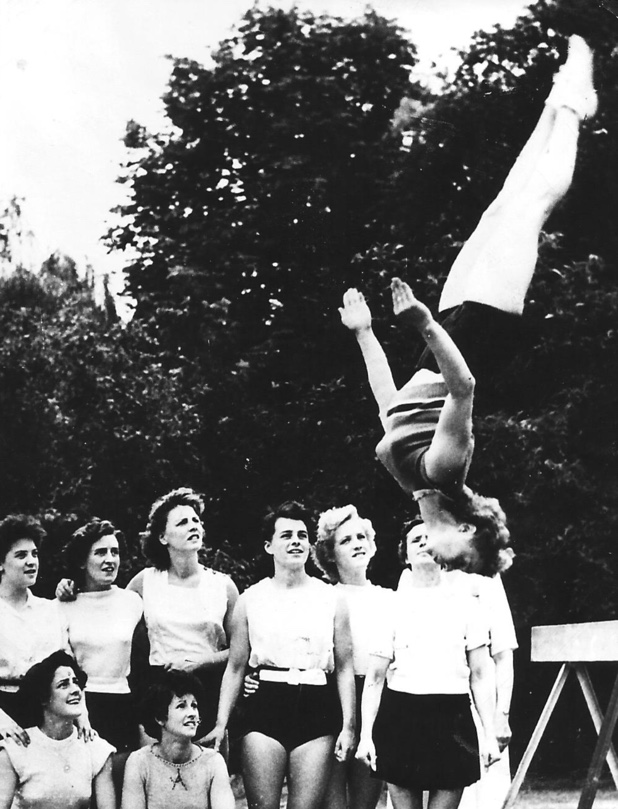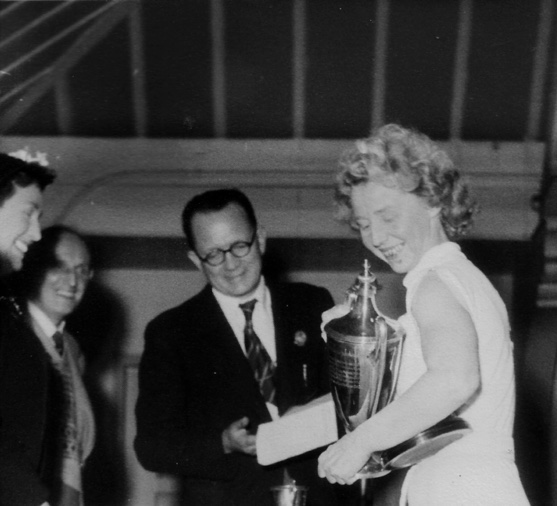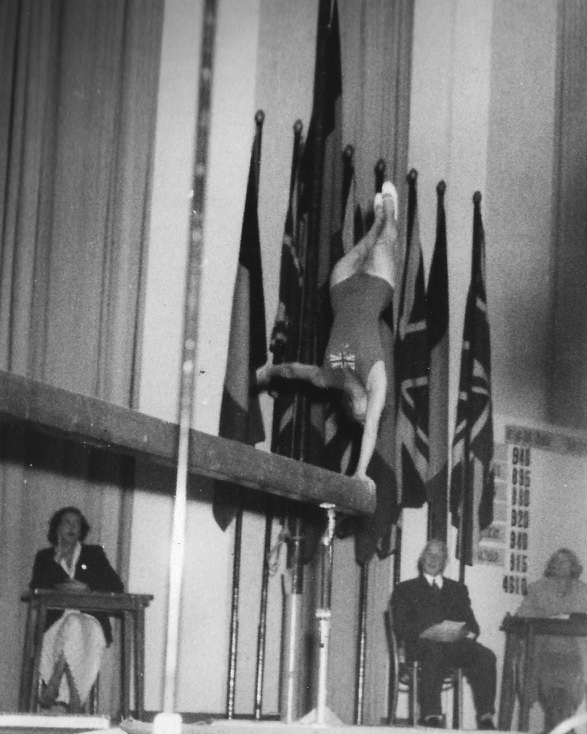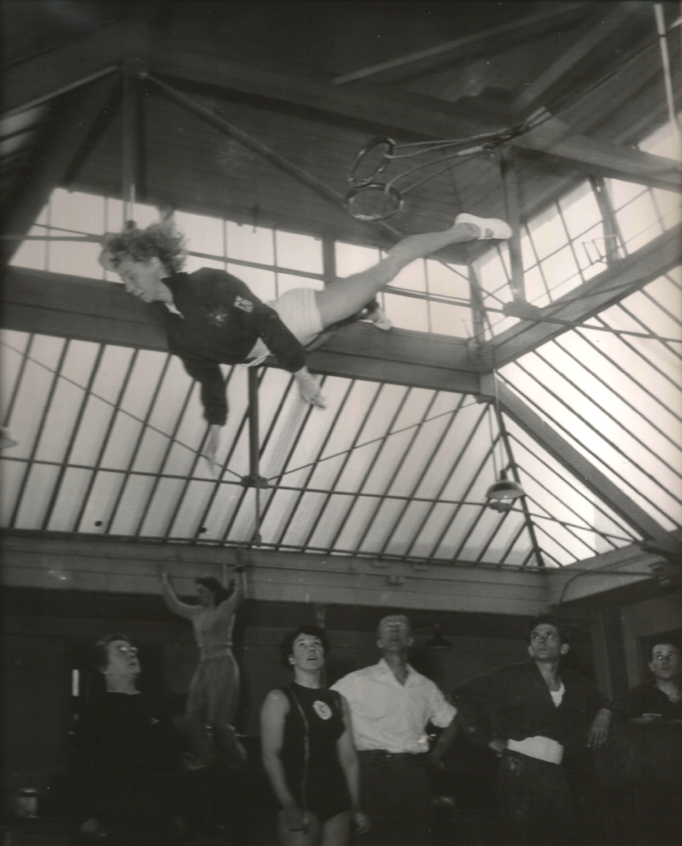PAT HIRST
by Meg Warren
Pat Hirst’s sporting career started many years ago. In fact so many that she was loathed to tell me just how many.
Strange as it may seem, this young lady who was later destined to compete in three Olympics, represent her country in many international competitions, and to hold the British Gymnastic title 8 times, had little love for the greatest sport of all. In fact, as a young schoolgirl, Pat, like many young girls and boys of today didn’t quite know what gymnastics were.
Whilst still at school, she did almost everything, swam, played cricket, tennis, netball, and athletics. On leaving
It was during 1936 that it can be said that her gymnastic career started. Perhaps it was the thrill of the Berlin Olympic Games which finally set off the spark of enthusiasm, for she decided then, that one day she would take part in an Olympic contest.
The next two years were spent training hard, entering every competition and championship, The Yorkshire, Northern Counties and British Championships. Pat became Yorkshire champion in 1938 and received her first Union Jack for an International against Belgium.
Then came the war. Pat’s former coach Jim Atkinson asked her to judge a local club gymnastic competition and then invited her to go back to the gym. It was not long before the old enthusiasm returned, but to her surprise and disappointment, her gymnastics did not. Pat’s performance was very poor and she had to start at the bottom again. Her recovery must have been rapid for that year brought her the Yorkshire Championship for the second time and that most coveted title, the Champion of England. The greatest name in ladies’ gymnastics at that time was Clarice Hanson, and Pat, in beating her had indeed reached the top. It is to her credit that Pat feels Clarice Hanson was unlucky on that day. She was leading all through the competition and then missed a vault which lost her sufficient marks to give Pat the British Championship, but then that is gymnastics, and Pat was to face the wrath of Lady Luck many times during the next ten years. The following year, the scales of fate swung the other way, for a dislocated elbow gave the championship to Clarice Hanson. But it was now
The British team which made such a gallant effort against the beautifully trained American and Continental teams was captained by none other than Miss Pat Hirst
The next four years saw a series of titles and championships come the way of our gymnast. It seemed that nothing could stop her being British Champion year after year. But something did. Walter Walsh and Cissie Davies managed to thwart Pat’s progress for just one year, and the British title went to Swansea for the first time, in 1951. The following year saw further honours come the way of our determined girl from Leeds. The British Championship came back with a vengeance, by a margin of 24 points. Again it was
The Olympic year of 1952 saw the return of the High and Low Bars, a piece of apparatus seldom seen in this country. Nevertheless, Pat who by now was ten years older than the average age of the team, mastered this new and difficult obstacle, and so rightly deserved her popularity in the team, for she so readily passes on her experiences and gives encouragement to the younger team members.
The following years saw the unbelievable happen, Pat just went on and on, 1953, 1954, 1955, 1956, the British title each year, bringing her total to 8, and once again it was Olympic year.
The Games in 1956 were held in Melbourne, Australia, and because of the expense involved, only two men and one lady were to go, together with a team manager. The few months prior to the final selection were a nightmare for the three lady gymnasts, whose hearts were so set on realising the greatest honour a sportsman or sportswoman can earn. Gwynedd Lingard, Margaret Neale and Pat Hirst. Trial after trial was arranged by the selectors in the hope of choosing the one to fly to Melbourne, but the girls from Wales were not intending to lose that honour without a determined fight.
When Nick Stuart, Frank Turner and Frank Edmonds boarded the plane for Melbourne, they were accompanied by Pat Hirst, who with Frank Turner, have between them made Olympic Gymnastics history by competing in a total of six Games.
After the Melbourne visit, she decided that active gymnastics were at an end, and hoped to concentrate on coaching, but in 1958 after a year of inactivity, she again succumbed to the call of competition. Alas for our story and Pat. Margaret Neale was on her usual good form, and in Pat’s own words “truly deserved to win.”
So Pat’s ambition of 1936 had been surely exceeded, threefold. One might imagine that she had given enough to the toughest of all sports, but it is not the end. Pat has one further ambition, to coach an Olympic team, and if she applies the same determination during the years to come as she has done during the past, then, I think her last ambition will be realised.
Notes
1948 We would have had a silver medal tied on vault if there had been an Individual Apparatus Championships.
Pat did indeed come 2nd to Karin Lindberg scoring 8.7, Lindberg 8.75 in the compulsory vault. However the results for compulsory and voluntary combined were:
Karin Lindberg Sweden 23.2
Clara Schroth USA 22.3 silver
Joan Airey GB 22.3 silver
Pat Hirst Obituary
Gymnastics Olympian Pat Hirst has died at the age of 77. Pat remains the all-time women’s British Championships record holder for gymnastics with 8 wins. Pat was born in Wortley and lived all her life in Leeds. She was a British Team member for 18 years, a remarkable career that started in 1938 in Belgium. Pat competed at 3 Olympic Games, London in 1948, and Helsinki in 1952 when she was
Further notes
It is confusing regarding the apparatus used from 1936 – 1952.
According to the official Olympic report for the 1936 games, the programme was Group floor exercise without hand apparatus and 2nd exercise with hand apparatus.
Bars Compulsory exercise on Asymmetric bars, Voluntary exercise on Parallel bars, Vault Compulsory exercise, no pommels, no springboard. Thief vault, no hands so this was a leap over the horse.
It seems that this was with a spring-board and may have been a higher horse judging by film taken at the ’36 Olympics.
Beam Compulsory exercise. Voluntary exercise It said in the rules that the beam was 4cms wide Looking at photos and film it is obviously 4 inches wide.
In 1948, the exercises were as follows –
- Team exercise without hand apparatus
- Team exercise with hand apparatus
- Compulsory swinging rings
- Compulsory & Voluntary Beam
- Vaulting horse with pommels, compulsory and voluntary. One warm-up vault followed by 2 vaults for each.
In the 1952 Olympics, the modern day Olympic programme was introduced;
Vault, Asymmetric Bars, Beam and Floor exercise.
The talk of the sudden change from P bars to A bars was possible that federations or just the AGA were led to believe that the apparatus for 52 would be P bars even though they had not appeared in the 1948 programme. It was only one year before that the decision was made to make the Asymmetric bars the new women’s apparatus. Gwynned Lingard spoke to me regarding this sudden change.
CLICK IMAGES TO VIEW FULL SIZE
© GymnasticsHistory.co.uk 2023 | Est. 2018





